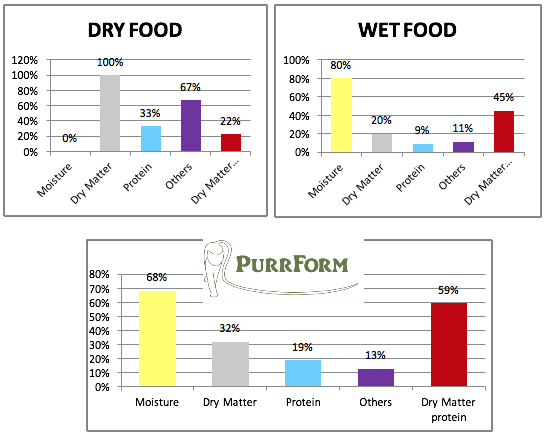What are you really feeding your Cat?
Pet food manufacturers use a variety of marketing tactics to encourage pet owners to purchase their foods. Many pet food companies are producing products that are marketed as being “natural”, a term which resonates with many pet owners who are seeking healthy choices for their pets. But what does the term “natural” really mean and does it equate with quality nutrition for your pet?
PurrForm complete raw cat food use only human grade meat of a high quality to ensure that your cat’s diet is easily digestible. No fillers, grains or palatable enhancements are added to any of our recipes. Our process is very simple, we mince the meat and bone, add some offal to create a balanced diet. We then vacuum pack and freeze blast the pouches to keep all the goodness and the freshness of the meat.
In addition, the meat, bone and offal are used in the correct ratio, which makes the food highly digestible. Some raw foods contain a high level of bone which is less nutritional and can have adverse effects, such as constipation.
Food which is high in protein can be fed in smaller quantities, whilst still giving the correct calorific content. This is because a cat’s body is designed to absorb protein, so most of the food is utilised, giving it the energy levels it needs, with little of the food being expelled in the faeces. Cats require only a small level of carbohydrate and do not possess the enzymes necessary to break down vegetable matter. Therefore, foods that contain these ingredients in too high levels, do not provide the cat with enough calories, hence more of the food needs to be fed to the cat, to enable it to be ‘satisfied’ and feel full.
So reading and understanding your pet food label is one of the best ways to determine the quality of the food you are feeding. The ingredients and the guaranteed analysis are included on the food label. In addition to providing information about the amount and quality of protein and fat, the label will also provide the ingredients and general feeding guidelines.
As we know, cats are a true carnivore and as a pet owner we do have the responsibility to ensure that we give our felines an appropriate diet high in protein content. Unfortunately our cat relies on us when it comes to food as they cannot do their own shopping and choose what is best for them!
So what should you know when it comes to choosing your cat food? The most important analytical constituent is of course the percentage of protein. The listings on the label are for the food as it is fed, not as it would be on a dry matter basis. So without converting each brand of food to a dry matter basis, you will not be able to compare them accurately. Fortunately, the conversion is not that complicated.
If a dry cat food has 10% moisture we know that it has 90% dry matter. So we look at the label and check the protein level that reads 20%. Next, we divide the 20 percent protein by the 90% dry matter and we get 22%, which is the amount of protein on a dry matter basis.
Now let us compare this to canned food that has 80% moisture. We know that with 80% moisture we have 20% dry matter. The label shows 5% protein. So we take the 5% and divide it by 20% and we get 25% protein on a dry matter basis. So the canned food has more protein per pound on a dry matter basis after all the water is taken out.
Remember water is cheap and yet some companies are charging a premium price for their “Premium brand”.
Below are 3 graphs to demonstrate the content of DM protein (Dry Matter) which highlights the actual protein that cats eat when served these meals.
CHART COMPARISONS
The dry matter protein is highlighted in brick colour on all the charts
